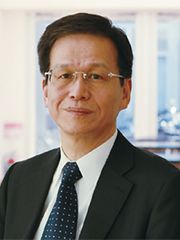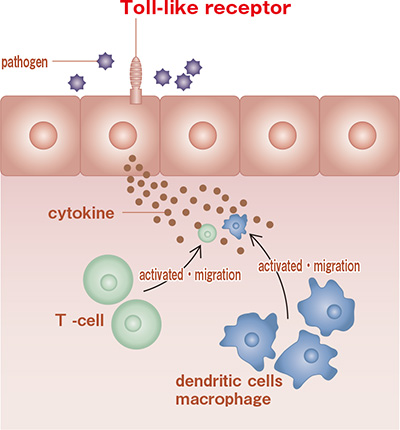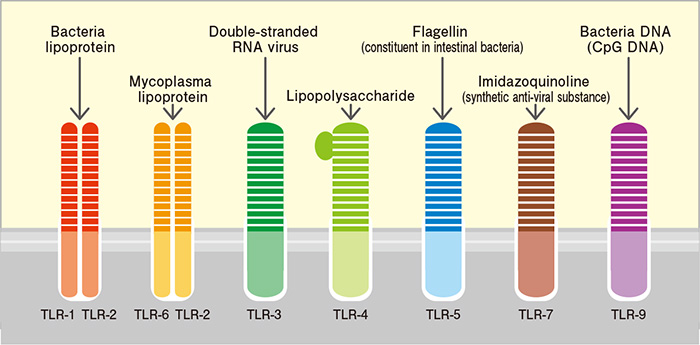Research Results
Revolutionize the common knowledgeof immunology!
The role of innate immunity FY2016

- Shizuo Akira (Professor/Director, WPI Immunology Frontier Research Center, Osaka University)
- CREST
- Host Defense Mechanism "Studies on Host Defense Mechanisms by Gene Targeting" Research Director (1995-1999)
- SORST
- "Elucidating the Molecular Mechanism of the Natural Immunity System" Core Researcher (2000-2001)
- ERATO
- "Akira Innate Immunity Project" Research Director (2002-2007)
An enduring contribution to the study of innate immunity
The 2011 Nobel Prize in Physiology or Medicine was awarded to 3 researchers in the field of immunology: French molecular biologist Jules A. Hoffmann, Bruce Alan Beutler of the Scripps Research Institute (USA), and Ralph M. Steinman of Rockefeller University (USA). All three share the distinction of having explicated the refined workings of innate immunity, which serves as a biological defense for living organisms but which had previously been considered primitive.
However, there is another researcher in this field whose contributions are no less impressive than the aforementioned three: Professor Shizuo Akira. In addition to winning several prestigious international awards for medical science such as the Robert Koch-Prize, one of the best German medicine prize in 2004, andCanada Gaidner International award in 2011 Professor Akira has continuously appeared on the US Thomson Scientific (present Thomson Reuters) "World's Hottest Researchers"list, ranking 8th in 2004, 1st in 2005 and 2006, and 4th in 2007, with his contributions to innate immunity research recognized on a world level.
The role that innate immunity plays in almost all living organisms
Immunity is known as the mechanism that protects our bodies against viruses and bacteria, but there are many details of the immune mechanism that remain unclear. Innate immunity, in particular, is often dismissed as the body's most primitive immune response, which simply digests and fights off any pathogens that invade the body. On the other hand, adaptive immunity is a system found only in vertebrates (such as mammals) which boasts an advanced learning capability that remembers pathogens and immediately eliminates them if the same pathogen ever invades the body again. Adaptive immunity has been the subject of exhaustive research, such as in vaccine development and more. Until the late 1990s, adaptive immunity was widely considered to represent all immune function, with immunology textbooks even stating that while the term"innate immunity"contained the word"immunity,"it did not actually represent an immune function.
Changing of immune system concept

Could fruit fly immune receptors be relevant to humans?
In 1996, the role of Toll receptors in the innate immunity of Drosophila fruit flies was discovered by French molecular biologist Jules Hoffmann's group at the Institut de Biologie Moléculaire et Cellulaire (IBMC). They reported that fruit flies lacking these Toll receptors had no innate immunity function, were overcome by fungus, and eventually died. Subsequently, Toll-like receptors were found to exist in all kinds of insects, with similar proteins also found to exist in the human body. Since these human proteins resemble the Toll receptors found in flies, they were given the name"Toll-like receptors." Professor Akira conducted repeated experiments on "knockout mice"* to find out what sort of action 12 kinds of Toll-like receptors have in the mammal body. He finally discovered that all of Toll-like receptors were responsible for recognizing different bacteria or viruses.
Professor Akira had discovered that these Toll-like receptors played an important role in linking innate immunity and adaptive immunity, which had previously been considered two completely separate systems; this completely overturned conventional wisdom in the field of immunology. Far from being just a primitive immune response, innate immunity has now been recognized as playing an essential role within adaptive immunity.
Induction of immune reaction

Cells detect pathogens through the toll-like receptors and inflammatory proteins called cytokine are secreted, which recruits and activates T-cell, dendritic cells and macrophage, leading to a multiple of immune reactions
Toll-like receptor (TLR) family and known active
ingredients Antiviral synthetic compound

Helping develop pharmaceutical treatments for hayfever, etc.
Professor Akira's discovery has already proven useful in the research and development of pharmaceuticals targeting innate immunity: for example, in the development of drugs to treat hayfever, which with 20 million sufferers across Japan has been described as Japan's national disease, as well as atopic eczema and more.
It has also found partial practical applications in medication for infectious diseases such as herpes, among others. In the scant 10+ years since Professor Akira's discovery, the field of immunology has evolved at great speed. In future, clearer understanding of immune mechanisms is expected to enable treatments not only for diseases linked to abnormal immune responses, but also for intractable diseases such as cancer.
This research, which started with Toll receptors discovered in fruit flies, has garnered immense interest worldwide as research that could critically influence humanity's future.
Subsequent research has determined that toll receptors and toll-like receptors are structurally similar, but significantly different in function. There remains no doubt that a huge diversity of living creatures found on earth is protected by such advanced innate immunity systems.
* A gene knockout mouse of which a specific gene is artificially damaged so as not to function
